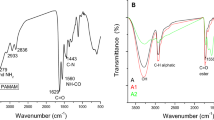Abstract
Aiming to achieve different characteristics with polypropylene copolymer, especially in relation to transparency similar to glass packaging, the effect of the addition of a clarifying agent derived from sorbitol to the polypropylene copolymer was studied. A specific cup shape packaging used for Brazilian cream cheese was applied. The samples were produced with different amounts of clarifying agent and were injected in industrial equipment. Further, the samples were characterized in regard to optical, mechanical and thermal properties. The results confirmed that the addition of clarifying agent, besides improving the transparency of the polypropylene copolymer, also increases the tensile strength. Moreover, from the view of applicability, the clarifying agent was demonstrated to be advantageous for the polypropylene copolymer production of Brazilian cream cheese packaging.







Similar content being viewed by others
References
Albán Harol Mauricio Gámez, Cardona OCS, Argueta CM, Sarmiento AT (2015) A cost-efficient method to optimize package size in emerging markets. Eur J Oper Res 241:917–926. https://doi.org/10.1016/j.ejor.2014.09.020
Coles R (2003) Packaging design and development. In: Coles R, McDowell D, Kirwan MJ (eds) Food packaging technology. CRC Press LLC, London, p 346
Vermeiren L, Devlieghere F, Van Beest M et al (1999) Developments in the active packaging of foods. Trends Food Sci Technol 10:77–86
Galić K, Ščetar M, Kurek M (2011) The benefits of processing and packaging. Trends Food Sci Technol 22:127–137. https://doi.org/10.1016/j.tifs.2010.04.001
Brody AL, Bugusu B, Han JH et al (2008) Innovative food packaging solutions. J Food Sci 73:107–116. https://doi.org/10.1111/j.1750-3841.2008.00933.x
Housmans J-W, Gahleitner M, Peters GWM, Meijer HEH (2009) Structure–property relations in molded, nucleated isotactic polypropylene. Polymer 50:2304–2319. https://doi.org/10.1016/j.polymer.2009.02.050
Mark J, Kirwan JWS (2003) Plastics in food packaging. In: Coles R, McDowell D, Kirwan MJ (eds) Food packaging technology. CRC Press LLC, London, UK, p 346
Libster D, Aserin A, Ni Garti (2007) Advanced nucleating agents for polypropylene. Polym Adv Technol 18:685–695. https://doi.org/10.1002/pat
Hoffmann K, Huber G, Mader D (2001) Nucleating and clarifying agents for polyolefins. Macromol Symp 176:83–91. https://doi.org/10.1017/CBO9781107415324.004
Thierry A, Straupe C, Wittmann JC, Lotz B (2006) Organogelators and polymer crystallisation. Macromol Symp 241:103–110. https://doi.org/10.1002/masy.200650915
Kristiansen M, Tervoort T, Smith P (2005) Mechanical properties of sorbitol-clarified isotactic polypropylene: influence of additive concentration on polymer structure and yield behavior. Macromolecules 38:10461–10465
Simanke AG, de Azeredo AP, de Lemos C, Mauler RS (2016) Influence of nucleating agent on the crystallization kinetics and morphology of polypropylene. Polímeros 26:152–160. https://doi.org/10.1590/0104-1428.2053
Shepard TA, Delsorbo CR, Louth RM et al (1997) Self-organization and polyolefin nucleation efficacy of 1,3:2,4-di-p-methylbenzylidene sorbitol. J Polym Sci Part B Polym Phys 35:2617–2628. https://doi.org/10.1002/(sici)1099-0488(19971130)35:16%3c2617:aid-polb5%3e3.0.co;2-m
Kristiansen M, Werner M, Tervoort T et al (2003) The binary system isotactic polypropylene/bis(3,4-dimethylbenzylidene)sorbitol: phase behavior, nucleation, and optical properties. Macromolecules 36:5150–5156. https://doi.org/10.1021/ma030146t
Foresta T, Piccarolo S, Goldbeck-wood G (2001) Competition between a and g phases in isotactic polypropylene: effects of ethylene content and nucleating agents at different cooling rates. Polymer 42:1167–1176
Kristiansen PM, Gress A, Smith P et al (2006) Phase behavior, nucleation and optical properties of the binary system 5-benzene-tricarboxamide. Polymer 47:249–253. https://doi.org/10.1016/j.polymer.2005.08.053
Marco C, Ellis G, Gomez MA, Arribas JM (2002) Comparative study of the nucleation activity of third-generation sorbitol-based nucleating agents for isotactic polypropylene. J Appl Polym Sci 84:2440–2450. https://doi.org/10.1002/app.10533
Mubarak Y, Martin PJ, Mubarak Y, Martin PJ (2013) Effect of nucleating agents and pigments on crystallisation, morphology, and mechanical properties of polypropylene Effect of nucleating agents and pigments on crystallisation, morphology, and mechanical. Plast Rubber Compos Macromol Eng 8011:307–315. https://doi.org/10.1179/146580100101541111
Menyhárd A, Gahleitner M, Varga J et al (2009) the influence of nucleus density on optical properties in nucleated isotatic polypropylene.pdf. Eur Polym J 45:3138–3148
Tenma M, Mieda N, Takamatsu S, Yamaguchi M (2007) Structure and properties for transparent polypropylene containing sorbitol-based clarifier. J Polym Sci Part B Polym Sci 46:41–47
Bernland K, Theo T, Smith P (2009) Phase behaviour and optical and mechanical properties of the binary system isotactic PP and the clarifying agent.pdf. Polymer 50:2460–2464
Kobayashi T, Takenaka M, Saijo K, Hashimoto T (2003) Self-assembly and morphology of gel networks in l, 3: 2, 4-bis- O-(p -methylbenzylidene)-D-sorbitol/n-dibutylphthalate. J Colloid Interface Sci 262:456–465. https://doi.org/10.1016/s0021-9797(03)00150-4
Zhao Y, Vaughan AS, Sutton SJ, Swingler SG (2001) On the crystallization, morphology and physical properties of a clari ® ed propylene/ethylene copolymer. Polymer 42:6587–6597
Acknowledgements
The authors are grateful to Bemis Company, Braskem S.A., Milliken Chemicals, Videplast, and the Federal University of Santa Catarina (UFSC) for their technological support and laboratory structure.
Author information
Authors and Affiliations
Corresponding author
Additional information
Publisher's Note
Springer Nature remains neutral with regard to jurisdictional claims in published maps and institutional affiliations.
Rights and permissions
About this article
Cite this article
Drummond, C.F., Damas, M.S.P., Merlini, C. et al. Influence of clarifying agent on the properties of polypropylene copolymer industrially injected cups for Brazilian cream cheese. Int J Plast Technol 23, 170–176 (2019). https://doi.org/10.1007/s12588-019-09245-4
Received:
Accepted:
Published:
Issue Date:
DOI: https://doi.org/10.1007/s12588-019-09245-4




